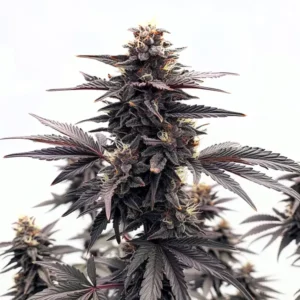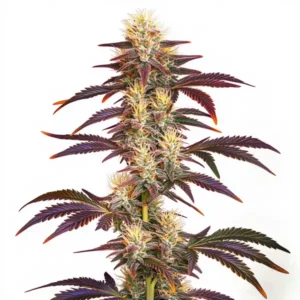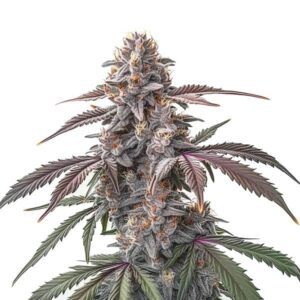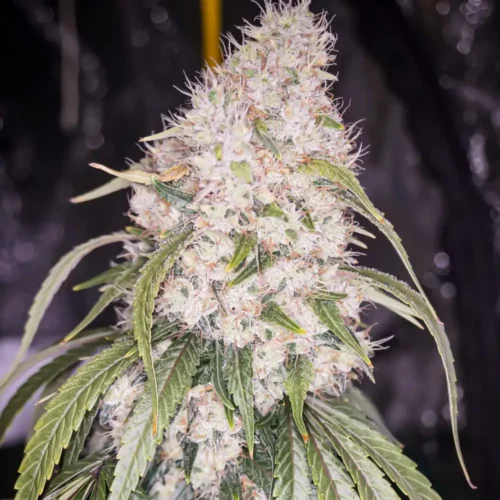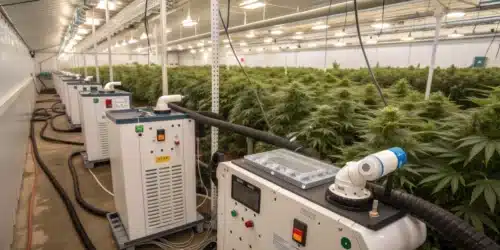Grape Ape Weed Strain Description
The Grape Ape Strain is a highly regarded, indica-dominant grape ape hybrid created by crossing Afghani, Mendocino Purps, and Skunk #1. Known for its calming effects, Grape Ape has earned a reputation among recreational and medicinal users for its powerful body-high. The strain typically offers a THC content ranging from 15% to 25%, making it ideal for evening use and stress relief.
Recommended Strains
Grape Ape
 THC: 15% - 25%
THC: 15% - 25% Type of seed: Feminized
Type of seed: Feminized Phenotype: Mostly Indica
Phenotype: Mostly Indica Day to flower: 8 - 10 weeks
Day to flower: 8 - 10 weeks
The buds of this strain are dense, with deep shades of purple, green, and a thick coating of trichomes. Its aroma profile is notably sweet with undertones of skunk, making it a memorable strain in both flavor and scent. The hashish and sweet flavors linger after consumption, contributing to the strain’s broad appeal.
This strain stands out not only for its potent effects but also for its versatility in different growing conditions, whether indoors or outdoors. It’s suitable for beginner growers due to its high resistance to pests and diseases. Below, we break down everything you need to know about how to grow cannabis, particularly Grape Ape strain grow info, from seed, to achieve optimal results.
Promos & Deals
Environmental Requirements for Growing Grape Ape Weed Strain
Creating the right environment for growing Grape Ape Weed Strain is essential for maximizing yields and potency. This strain thrives in warm, temperate climates, where daytime temperatures hover between 70-80°F (21-27°C). While the strain is quite hardy, maintaining slightly cooler night temperatures helps encourage the rich purple hues that are characteristic of Grape Ape.
For those growing indoors, it’s important to provide adequate lighting to ensure vigorous growth. High-quality LED grow lights or HPS lamps are excellent options to support both vegetative and flowering phases. During the vegetative stage, Grape Ape requires around 18-20 hours of light per day. When transitioning to the flowering stage, adjust to a 12/12 light cycle to encourage bud development.
Humidity control is another critical factor. During the vegetative stage, aim for 60-70% humidity. However, during flowering, reduce humidity to around 40-50% to avoid issues like mold and bud rot, especially considering Grape Ape’s dense bud structure.
Setting Up the Growing Cannabis Space
Indoor Cannabis Cultivation
When growing Grape Ape indoors, setting up the right space is crucial for the strain’s success. A dedicated grow tent or room with proper ventilation is key. Good airflow helps to prevent moisture buildup, which can lead to mold, especially in strains like Grape Ape with tightly packed buds. Installing carbon filters is essential to control the strong skunky odor produced during flowering.
To ensure maximum light reflection and coverage, line the walls with reflective materials like Mylar. This helps distribute light evenly across the plant canopy. Use a soil medium that drains well or try a hydroponic setup if you prefer more control over nutrients. Maintaining the correct pH (6.0-6.5) ensures that the plant absorbs nutrients efficiently.
Outdoor Cannabis Cultivation
For outdoor grape ape strain growers, Grape Ape performs exceptionally well in areas with warm climates and long summers. Ensure that your plants receive full sunlight for at least 6-8 hours per day to maximize yields. If you’re growing in containers, opt for large pots that allow root expansion. Well-draining soil with organic nutrients is ideal for promoting healthy root development.
Support the branches with stakes or trellises as Grape Ape’s buds can become heavy, risking branch breakage. If you live in cooler regions, a greenhouse can help extend the growing season and protect the plants from cold temperatures or rain.

Propagation and Germination of Grape Ape Weed Strain
Starting with high-quality Grape Ape feminized seeds from a reputable seed bank is the first step to a successful grow. The germination process is straightforward. Begin by soaking the seeds in distilled water or using a damp paper towel method for 24-48 hours until taproots appear. Keep the temperature between 70-85°F (21-29°C) to speed up the process.
Once the seeds have sprouted, transfer them to small pots filled with light, well-draining soil. Maintain a warm, humid environment during the early seedling stage with temperatures around 75-80°F (24-27°C) and humidity levels between 60-70%.
Providing gentle airflow and indirect light is crucial during this phase. Avoid overexposure to intense light or heat, as this can stress the delicate seedlings. Once they’ve developed a few sets of true leaves, they are ready to be transplanted into larger pots or directly into the outdoor growing area.
Vegetative Phase of Grape Ape Weed Strain
The vegetative phase is essential for building strong plants that can support the dense buds Grape Ape is known for. During this stage, the plant focuses on growing leaves, branches, and root systems. Ensure that you provide ample light (18-20 hours a day) and maintain a consistent watering schedule to avoid overwatering or underwatering.
Fertilize your plants with a high nitrogen (N) fertilizer to support leaf development. It’s also a good time to start training your plants through techniques like topping or low-stress training (LST). These methods help promote even light distribution, leading to a more uniform canopy and better bud development.
Flowering Phase of Grape Ape Weed Seeds
Grape ape flowering time typically lasts 8-10 weeks. This strain is photoperiod-dependent, meaning you need to switch to a 12/12 light cycle for flowering. The dense, resinous buds begin to form during this phase, and their skunky, sweet aroma becomes more pronounced.
It’s important to transition your nutrient schedule to one that is higher in phosphorus (P) and potassium (K) during flowering to support bud development. Keep a close eye on humidity levels to prevent issues like bud rot. If possible, slightly reduce the temperature to bring out the purple hues that make the buds of the grape glue strain visually striking.
Cannabis Fertilization and Nutrition
Proper nutrition plays a significant role in ensuring your Grape Ape plants thrive. During the vegetative stage, focus on nitrogen-rich fertilizers. As the plant transitions into the flowering phase, switch to bloom-specific nutrients that are rich in phosphorus and potassium to enhance bud production.
Incorporating supplements like cal-mag (calcium and magnesium) helps prevent nutrient deficiencies that can impact growth. Regularly flushing the plants towards the end of the flowering period removes any nutrient buildup, which can enhance the final flavor profile of your buds.
Pest and Disease Control for Cannabis Growing
While Grape Ape is relatively resistant to pests and diseases, preventive measures are essential to protect your crop. Common pests like spider mites, aphids, and thrips can damage your plants if left unchecked. Regularly inspect your plants, and use organic pest control methods like neem oil or introducing beneficial insects such as ladybugs.
Mold and mildew can be concerns due to Grape Ape’s dense buds. Ensure proper airflow and maintain optimal humidity levels to avoid these issues.
Harvesting and Curing Grape Ape Weed Strain
Harvesting at the right time is key to maximizing the effects and flavors of Grape Ape. Use a magnifying glass to inspect the trichomes on the buds. When the majority are milky with a few turning amber, it’s time to harvest.
After cutting the branches, hang them upside down in a dark room with good ventilation. Aim for a temperature of 60-70°F and a humidity level around 50%. Once dried, cure the buds in glass jars, opening them daily during the first week to release excess moisture.

Is Grape Ape Weed Strain Indica or Sativa?
Grape Ape is predominantly an indica strain. Its effects are typically calming and sedative, making it an excellent option for stress relief and insomnia. While it carries some sativa traits from its Skunk #1 lineage, it’s well-known for providing a deep body high characteristic of indica-dominant strains.
Advantages of Growing Grape Ape Weed Strain
- High yields of dense, resinous buds.
- Unique and pleasant skunky, sweet flavor.
- Relatively easy to grow, even for beginners.
- Strong resistance to pests and diseases.
Disadvantages of Growing Grape Ape Weed Seeds
- Requires close humidity control during flowering.
- Can be prone to mold if airflow is inadequate.
- Heavy buds may need additional support during flowering.
Why Buy Grape Ape Weed Strain
There are many reasons why you should consider purchasing Grape Ape Weed Strain for your next grow:
1. Exceptional Flavor: Grape Ape combines the best of sweet and skunky flavors. Its rich hashish undertones make it a favorite for those seeking a flavorful smoking experience.
2. Potent Effects: With THC levels that can reach up to 25%, Grape Ape delivers powerful relaxation and stress relief, perfect for winding down after a long day.
3. Medicinal Benefits: Due to its high THC content and indica-dominant genetics, this strain is popular among medicinal users for its ability to alleviate pain, insomnia, and anxiety.
4. Versatile Growing Conditions: Grape Ape performs well in both indoor and outdoor grape ape strain environments, making it a reliable choice for growers in various climates.
5. Beginner-Friendly: Grape Ape’s resilience against common pests and diseases makes it an excellent choice for novice cultivators, allowing them to grow high-quality cannabis with relative ease.
Problems in Growing Grape Ape Seeds
Despite its advantages, Grape Ape Weed Strain does have a few potential challenges:
1. Risk of Mold: Due to the dense structure of its buds, Grape Ape is susceptible to mold, especially if humidity levels are not controlled properly. Be sure to maintain optimal airflow and humidity during the flowering phase to avoid this issue.
2. Heavy Branches: The weight of Grape Ape’s buds can cause branches to bend or even break. Staking or trellising the plants during the late vegetative and flowering phases is recommended to provide additional support.
3. Odor Control: The strong, skunky aroma of Grape Ape can be difficult to manage for indoor growers. Implementing proper odor control measures, such as carbon filters, is crucial to avoid unwanted attention.
Strains Similar to Grape Ape Weed Strain
- Purple Kush: Another potent indica with relaxing effects and a similar purple hue.
- Granddaddy Purple: Known for its fruity flavors and sedative effects, this strain shares many characteristics with Grape Ape.
- Blackberry Kush: A hybrid with sweet berry flavors and a calming effect, making it a great alternative to Grape Ape.
Tips for Professional Growers
If you’re a professional grower, there are some additional steps you can take to maximize your Grape Ape harvest:
1. Advanced Training Techniques: Use high-stress training (HST) methods like topping or super-cropping to control plant height and encourage more lateral bud development. This ensures better light distribution and increases overall yield.
2. Precise Nutrient Management: Track your plant’s nutrient uptake and adjust accordingly. Monitoring the pH levels of both the growing medium and the nutrient solution can help prevent nutrient lockout and ensure optimal absorption.
3. Climate Control: For large-scale indoor grows, using automated systems to regulate temperature, humidity, and CO2 levels can significantly improve the quality of your harvest. Keep a close eye on humidity, especially during the flowering phase, to avoid mold.
FAQs About Grape Ape Weed Strain
What is the THC content of Grape Ape Weed Strain?
Grape Ape typically has a THC content ranging from 15% to 25%, depending on the growing conditions and phenotype.
How long does it take to grow Grape Ape Weed Strain?
The flowering period for Grape Ape lasts between 8 and 10 weeks, making it a relatively fast-flowering strain for an indica-dominant hybrid.
Can I grow Grape Ape indoors?
Yes, Grape Ape can be successfully grown indoors. It’s particularly suited to indoor cultivation due to its moderate height and dense bud structure.
What flavors can I expect from Grape Ape Weed Strain?
Grape Ape delivers sweet, skunky, and hashish flavors, with subtle hints of berries and earthiness, making it a rich and enjoyable smoke.
Is Grape Ape suitable for beginners?
Yes, Grape Ape is an excellent strain for beginners. Its resilience against pests and diseases, combined with its forgiving nature, makes it easy for novice growers to cultivate successfully.


